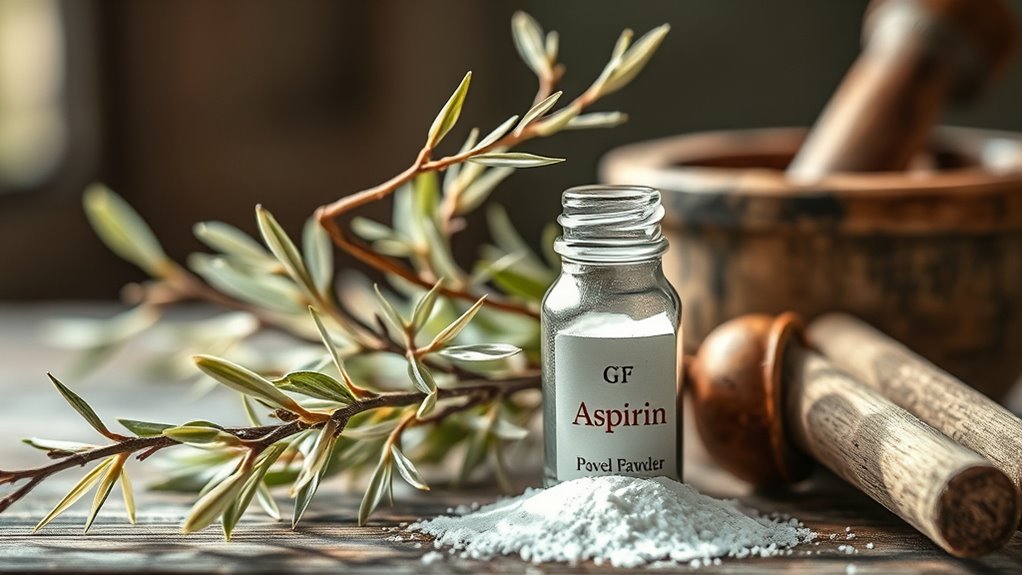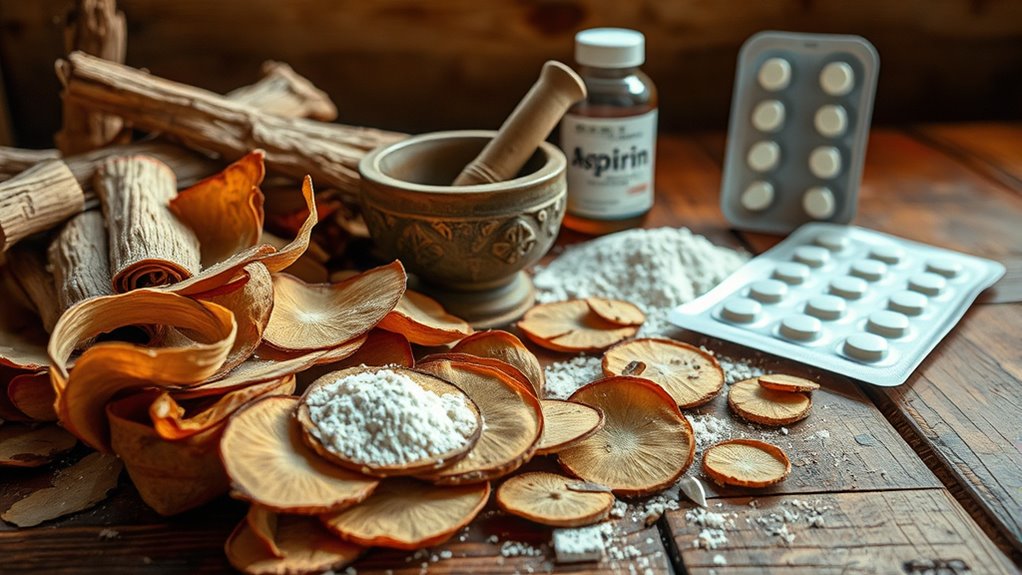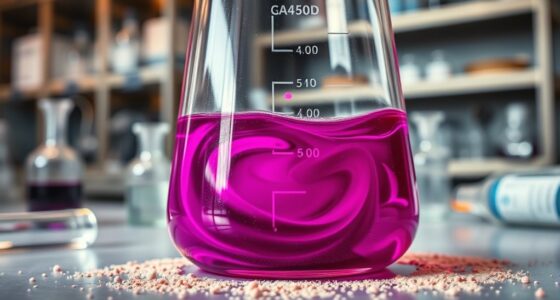The story of aspirin begins with ancient civilizations like the Egyptians and Greeks using willow bark to treat pain, fever, and inflammation. Scientists later identified the active compound responsible, leading to the development of acetylsalicylic acid in the late 19th century. This breakthrough allowed for mass production and safer, effective medication. If you explore further, you’ll discover how this natural remedy transformed into one of the world’s most widely used medicines today.
Key Takeaways
- Traditionally used by ancient civilizations to treat pain, fever, and inflammation from willow bark.
- Scientists isolated acetylsalicylic acid in the late 19th century, leading to aspirin’s development.
- Advances in manufacturing enabled large-scale, standardized production of synthetic aspirin.
- Aspirin became a global, widely used medicine for pain relief, fever reduction, and anti-inflammatory effects.
- Its evolution exemplifies how natural remedies can inspire modern pharmaceuticals through scientific progress.

Aspirin has come a long way from its humble beginnings as a natural remedy derived from willow bark. Historically, people have used willow bark for centuries to alleviate pain, reduce fever, and ease inflammation. Ancient civilizations, including the Egyptians and Greeks, recognized its medicinal properties. They would crush the bark and create poultices or infusions to treat headaches, muscle aches, and other ailments. These early uses laid the groundwork for understanding the plant’s medicinal potential, even if the active compound wasn’t isolated at the time. Over the centuries, scientists sought to identify the specific ingredients responsible for these effects, leading to a better understanding of how the natural remedy worked.
Fast forward to the late 19th century, when modern manufacturing processes began transforming the way aspirin was produced. Chemists succeeded in isolating acetylsalicylic acid—the active ingredient in willow bark responsible for its pain-relieving effects—making it easier to produce in a controlled, consistent manner. This breakthrough marked a turning point, allowing aspirin to be manufactured on a large scale and with standardized doses. The development of synthetic methods meant that aspirin could be mass-produced, making it more accessible and reliable than traditional herbal remedies. This shift from natural extraction to modern manufacturing paved the way for aspirin to become a cornerstone in medicine, used widely for its analgesic, antipyretic, and anti-inflammatory properties.
Today, the story of aspirin is a testimony to how scientific progress and technological innovation have expanded its reach. While the natural use of willow bark remains an important historical chapter, the modern manufacturing of aspirin ensures that millions of people worldwide benefit from its consistent quality and effectiveness. Advanced chemistry and manufacturing techniques have also improved safety, reducing side effects and enhancing efficacy. As a result, aspirin has evolved from a simple herbal remedy into a pharmaceutical blockbuster, integrated into countless medical treatments. Its journey from the natural world to the laboratory and beyond underscores both the enduring value of traditional remedies and the power of scientific advancement in turning natural substances into life-saving medicines. Additionally, the understanding of natural remedies has influenced modern pharmacology, leading to the development of many other important drugs. Whether used for everyday aches or in critical medical settings, aspirin’s history reflects a remarkable blend of tradition, innovation, and progress.
Frequently Asked Questions
How Did Aspirin Become a Mass-Market Medicine?
You see, aspirin became a mass-market medicine through key historical breakthroughs that improved its production and safety. As scientists refined its synthesis and understanding, demand grew, leading to market expansion. Pharmaceutical companies mass-produced it, making it affordable and widely available. This process transformed aspirin from a traditional remedy into a daily necessity, allowing millions to benefit from its pain-relieving and anti-inflammatory properties worldwide.
What Were the Early Challenges in Manufacturing Aspirin?
You face early challenges in manufacturing aspirin due to botanical sourcing and chemical synthesis. Extracting salicin from willow bark was inconsistent and costly, making large-scale production difficult. Chemists then developed synthetic methods to produce acetylsalicylic acid more reliably, but initial processes were complex and lacked efficiency. Overcoming these hurdles required refining chemical synthesis techniques and establishing stable, scalable production methods to meet growing demand.
How Did Aspirin’s Legal Status Evolve Over Time?
You see, aspirin’s legal status changed considerably over time due to regulatory changes and patent expirations. Initially, it was unregulated, but as its popularity grew, authorities introduced safety standards and approval processes. When patents expired, generic manufacturers entered the market, increasing accessibility and reducing costs. These regulatory adjustments and patent expirations helped establish aspirin as a widely trusted, over-the-counter medication, solidifying its place in healthcare worldwide.
Are There Any Natural Alternatives to Aspirin Today?
Did you know that nearly 80% of people worldwide rely on herbal remedies for health? Yes, there are natural alternatives to aspirin today, like willow bark and other plant-based drugs, which contain salicin, the compound aspirin was derived from. These options are popular for those seeking natural pain relief and anti-inflammatory effects without synthetic chemicals, making plant-based drugs a viable choice for many looking to avoid conventional medications.
What Are the Latest Research Developments Related to Aspirin?
Recent research shows advancements in understanding aspirin’s biochemical mechanisms, revealing how it inhibits COX enzymes to reduce inflammation and pain. You should also know that clinical trial advancements are exploring aspirin’s potential in preventing certain cancers and cardiovascular diseases. These studies aim to optimize dosage and minimize side effects, bringing new therapeutic uses into focus. Stay updated, as these developments could considerably impact your health management strategies.
Conclusion
So, next time you pop an aspirin, remember you’re literally swallowing centuries of ancient bark, all for that fleeting moment of relief. It’s amazing how a simple plant turned into a blockbuster drug that’s made billions—and you’re just one of millions unknowingly part of this grand herbal scam. But hey, who needs transparency when you can enjoy the placebo effect, right? Cheers to modern medicine’s humble, sneaky beginnings!









